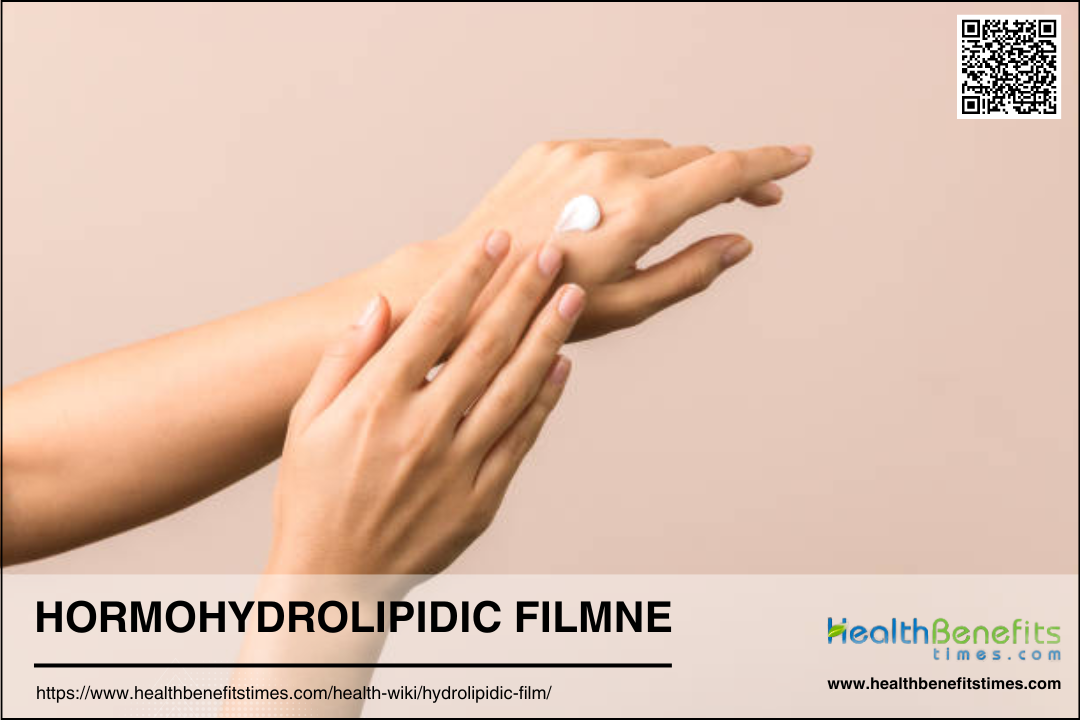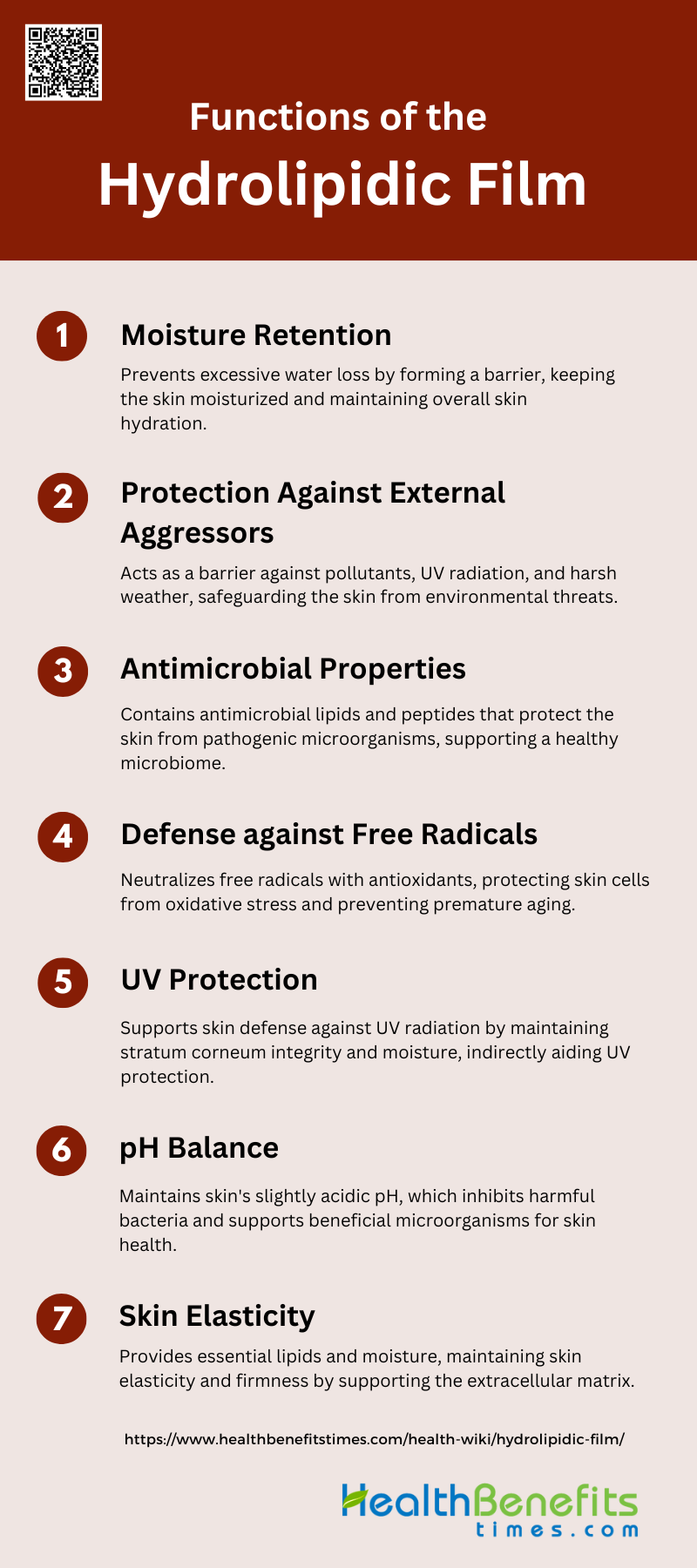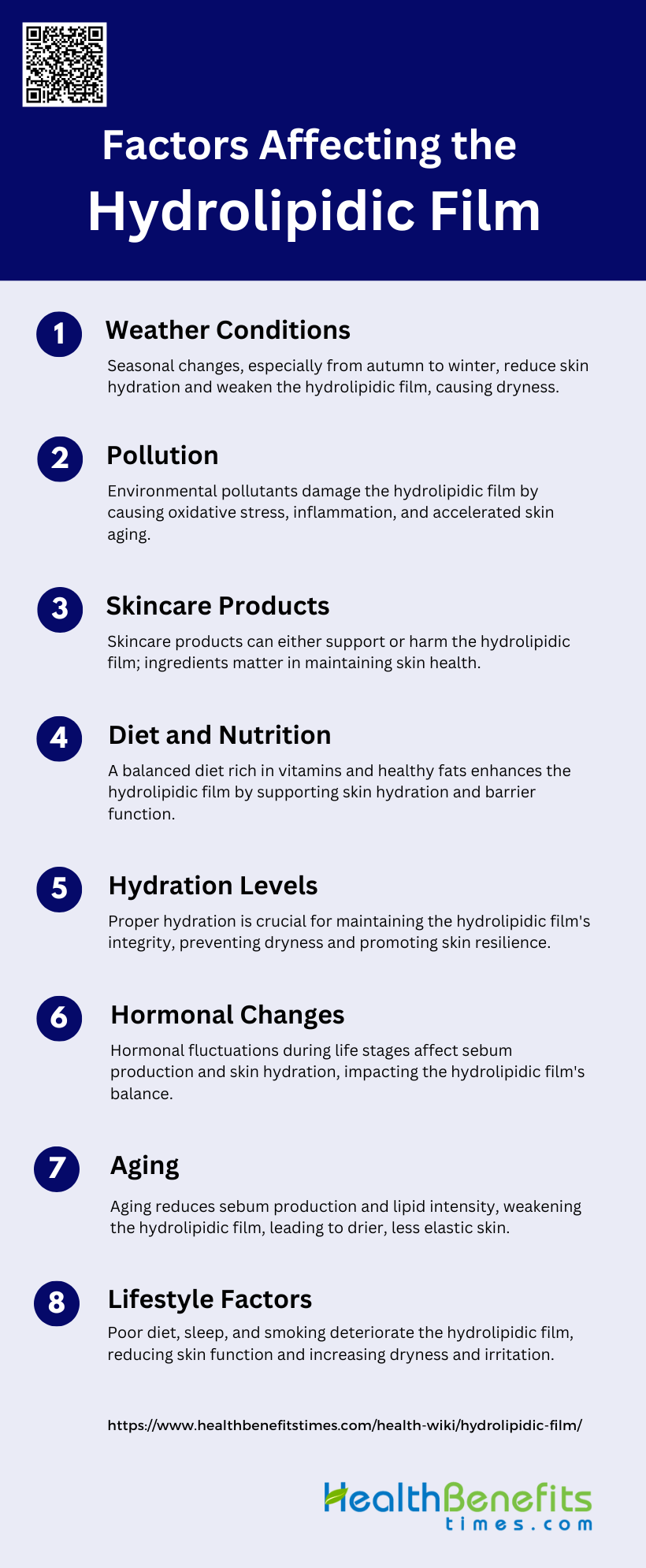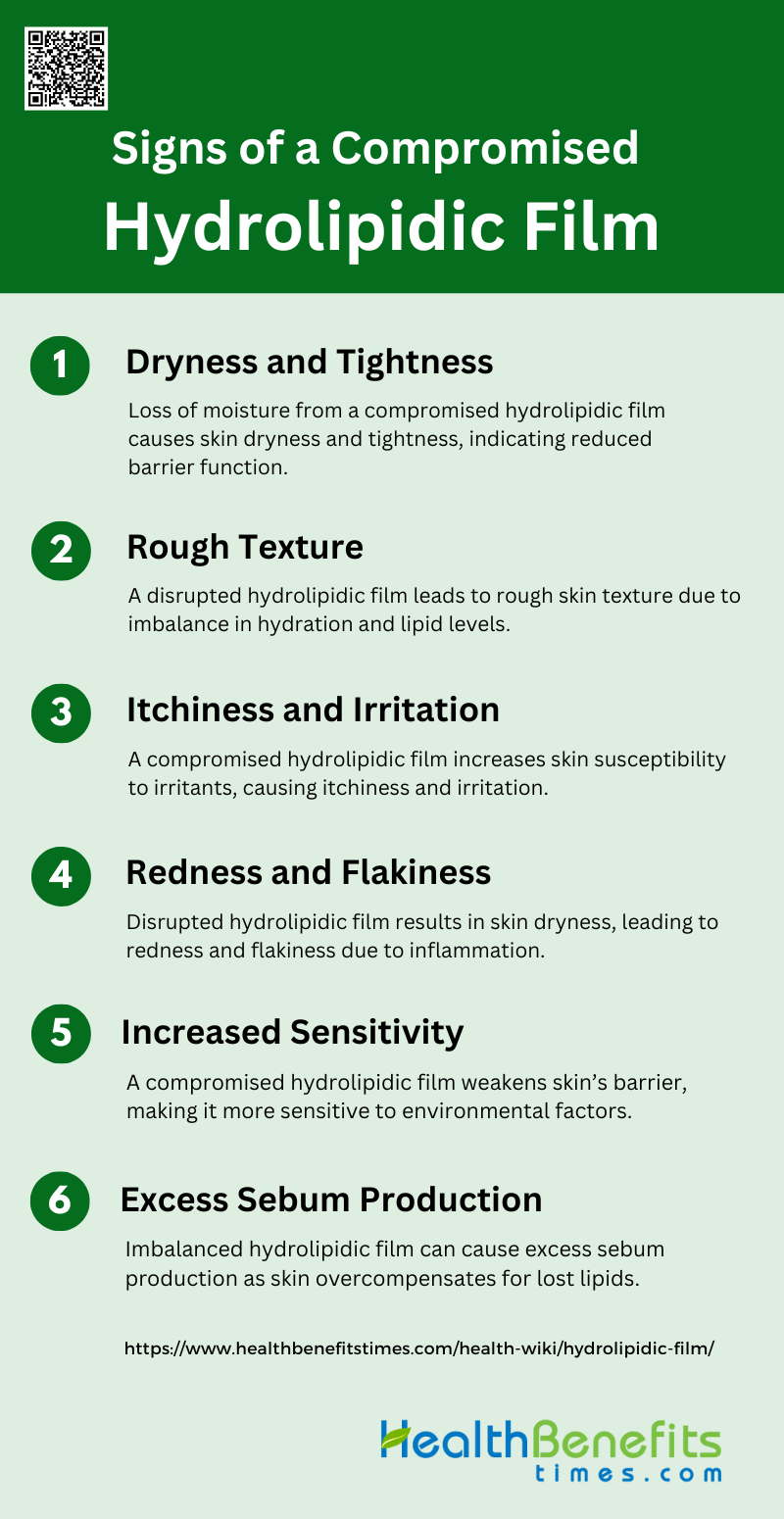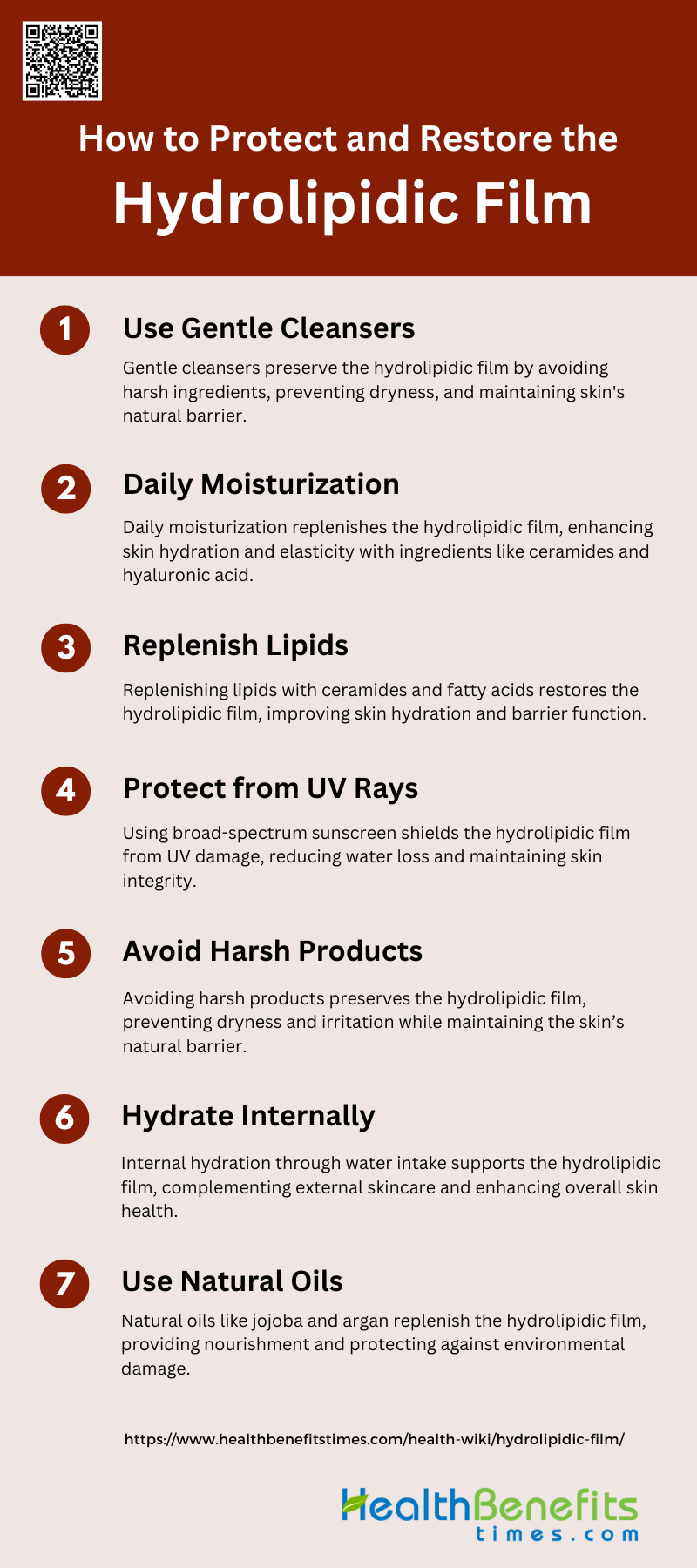The hydrolipidic film is a protective barrier on the surface of the skin, composed of water and lipids. This film plays a crucial role in maintaining skin health by providing a defense against environmental aggressors such as bacteria, pollutants, and harsh weather conditions. It helps to retain moisture, thus preventing dehydration and maintaining skin elasticity. The film is produced by the sebaceous glands, which secrete sebum, and the sweat glands, which release water. Together, these components create a slightly acidic environment that supports the skin’s natural flora and contributes to its overall resilience. Disruption of the hydrolipidic film can lead to skin issues such as dryness, irritation, and increased sensitivity.
Components of the hydrolipidic film
The hydrolipidic film is a critical protective layer on the skin’s surface, composed of both water and lipid components. This film plays a vital role in maintaining skin hydration, elasticity, and overall health. Below are the key components of the hydrolipidic film and their functions:
1. Water Content
The water content in the hydrolipidic film is crucial for maintaining skin hydration and overall skin health. Studies have shown that the water content in various tissues, such as perirenal adipose tissue, ranges between 15% and 20%, with slight variations depending on the specific location within the tissue. The water content in the stratum corneum, the outermost layer of the skin, is also a significant factor in skin appearance and function. Disruptions in this balance can lead to conditions like atopic dermatitis, where both skin moisture and lipid levels are reduced, resulting in dry skin. Additionally, water interacts with lipid polar headgroups in cellular membranes, playing a vital role in the function of membrane proteins.
2. Lipid Content
The lipid content of the hydrolipidic film is equally important, providing a barrier that helps to retain moisture and protect the skin. The lipid layer of the tear film, for example, is composed of meibomian lipids that stabilize the tear film by lowering its free energy and carrying water into the film during its formation. In the context of edible films, the addition of lipids improves water vapor barrier properties, although it can decrease mechanical properties. The lipid composition of the skin’s surface, including cholesterol esters and triglycerides, is essential for maintaining the hydrophobic barrier that prevents water loss and protects against external contaminants. In patients with atopic dermatitis, a reduction in skin lipids contributes to the clinical manifestation of dry skin, highlighting the importance of maintaining a balanced hydrolipidic film.
Functions of the Hydrolipidic Film
The hydrolipidic film serves as a crucial barrier on the skin’s surface, providing protection and maintaining moisture balance. It helps to shield the skin from external aggressors, prevent water loss, and support overall skin health. Below are the primary functions of the hydrolipidic film:
1. Moisture Retention
The hydrolipidic film plays a crucial role in maintaining skin hydration by preventing excessive water loss. This film, composed of sebum and sweat, forms a barrier that reduces transepidermal water loss (TEWL), thereby keeping the skin moisturized. Studies have shown that moisturizers can enhance this function by improving the skin barrier and surface moisture content. For instance, a clinical trial demonstrated that topical cosmetic moisturizers significantly improved skin barrier function and moisture retention, even under environmental stressors. This highlights the importance of the hydrolipidic film in sustaining skin hydration and overall health.
2. Protection Against External Aggressors
The hydrolipidic film serves as a frontline defense against environmental aggressors such as pollutants, UV radiation, and harsh weather conditions. It acts as a physical barrier that prevents the penetration of harmful substances into the skin. Research indicates that moisturizers containing specific ingredients can bolster this protective function. For example, a study found that a yeast extract-containing moisturizer enhanced the skin’s barrier function and protected against environmental pollutants by regulating the skin microbiome and reducing inflammatory markers. This underscores the film’s role in shielding the skin from external threats.
3. Antimicrobial Properties
The hydrolipidic film possesses inherent antimicrobial properties that help protect the skin from pathogenic microorganisms. This is achieved through the presence of antimicrobial lipids and peptides within the film. The stratum corneum, the outermost layer of the skin, contains low water content and an acidic pH, which are unfavorable conditions for pathogen colonization. Additionally, antimicrobial peptides are synthesized and delivered to the skin’s surface, enhancing its defense against microbial invasion. These mechanisms collectively contribute to the skin’s ability to fend off infections and maintain a healthy microbiome.
4. Defense Against Free Radicals
The hydrolipidic film also plays a role in defending the skin against oxidative stress caused by free radicals. Free radicals can damage skin cells, leading to premature aging and other skin issues. The film contains antioxidants that neutralize these reactive molecules. Innovative approaches, such as the use of hydrogel microcapsules with an oil layer, have been developed to enhance the retention and activity of antioxidants within the skin. These microcapsules mimic cellular defense systems, providing a controlled release of antioxidants and improving their efficacy in combating oxidative stress. This highlights the film’s role in protecting the skin from oxidative damage.
5. UV Protection
While the hydrolipidic film itself does not provide significant UV protection, it supports the skin’s overall defense mechanisms against UV radiation. The film helps maintain the integrity of the stratum corneum, which can reduce the penetration of UV rays. Additionally, the film’s moisture-retaining properties prevent the skin from becoming dry and more susceptible to UV damage. Some skincare products incorporate UV filters and antioxidants to enhance this protective function, providing a comprehensive approach to UV defense. Thus, the hydrolipidic film indirectly contributes to protecting the skin from harmful UV radiation.
6. pH Balance
The hydrolipidic film plays a vital role in maintaining the skin’s pH balance, which is crucial for its overall health and function. The film’s slightly acidic nature helps regulate the skin’s pH, creating an environment that is inhospitable to harmful bacteria while supporting the growth of beneficial microorganisms. This pH balance is essential for the skin’s barrier function and its ability to resist infections. Research has shown that the skin’s microbiota and barrier function are closely linked, with the hydrolipidic film playing a key role in maintaining this balance. This emphasizes the importance of the film in preserving the skin’s natural pH.
7. Skin Elasticity
The hydrolipidic film contributes to maintaining skin elasticity by providing essential lipids and moisture that keep the skin supple and resilient. The film’s lipid components, such as ceramides and fatty acids, are crucial for the structural integrity of the skin’s extracellular matrix. This matrix supports the skin’s elasticity and firmness. Studies have demonstrated that moisturizers can enhance skin elasticity by improving the lipid content and hydration of the skin. For instance, a study found that a specific moisturizer increased levels of collagen and elastin, key components of skin elasticity, in treated skin areas. This highlights the film’s role in supporting the skin’s structural integrity and elasticity.
Factors Affecting the Hydrolipidic Film
The hydrolipidic film is essential for skin protection and hydration, but various factors can influence its integrity and effectiveness. These factors can lead to imbalances, making the skin more susceptible to damage and dryness. Below are the key factors affecting the hydrolipidic film:
1. Weather Conditions
Weather conditions significantly impact the hydrolipidic film of the skin. Seasonal changes, particularly the transition from autumn to winter, can lead to increased transepidermal water loss (TEWL) and alterations in skin hydration levels. Studies have shown that during winter, the skin tends to become more reddish and scaly, indicating a compromised hydrolipidic layer. This is attributed to lower temperatures and reduced humidity, which can strip the skin of its natural lipids and moisture, leading to a functionally inferior hydrolipidic film. Therefore, weather conditions play a crucial role in maintaining the balance of the skin’s protective barrier.
2. Pollution
Pollution is another critical factor affecting the hydrolipidic film. Environmental pollutants, such as particulate matter and toxins, can penetrate the skin barrier, leading to oxidative stress and inflammation. These pollutants can disrupt the balance of skin lipids and moisture, resulting in a weakened hydrolipidic film. Chronic exposure to pollution has been linked to premature skin aging and various dermatological conditions, as it accelerates the degradation of essential skin components like ceramides and natural moisturizing factors. Thus, pollution significantly compromises the integrity and function of the hydrolipidic film.
3. Skincare Products
The use of skincare products can either support or disrupt the hydrolipidic film. Products containing harsh chemicals, alcohol, or fragrances can strip the skin of its natural oils and moisture, leading to dryness and irritation. Conversely, products formulated with ceramides, hyaluronic acid, and other hydrating ingredients can help restore and maintain the hydrolipidic balance. Proper skincare routines that include gentle cleansers, moisturizers, and sunscreens are essential for preserving the integrity of the hydrolipidic film and protecting the skin from environmental stressors. Therefore, the choice of skincare products plays a pivotal role in the health of the hydrolipidic film.
4. Diet and Nutrition
Diet and nutrition have a profound impact on the hydrolipidic film. Nutrients such as vitamins, minerals, and essential fatty acids are crucial for maintaining skin health. For instance, vitamin C and collagen can enhance ceramide production, thereby improving skin hydration and barrier function. Probiotics have also been shown to positively influence skin hydration by modulating the skin’s microbiome. A balanced diet rich in antioxidants and healthy fats supports the skin’s natural lipid barrier, reducing transepidermal water loss and maintaining the hydrolipidic film. Thus, proper nutrition is vital for the optimal function of the skin’s protective barrier.
5. Hydration Levels
Hydration levels are directly linked to the condition of the hydrolipidic film. Adequate water intake is essential for maintaining skin moisture and elasticity. The stratum corneum, the outermost layer of the skin, relies on sufficient hydration to function effectively as a barrier. Dehydration can lead to a compromised hydrolipidic film, resulting in dry, flaky skin and increased susceptibility to irritants. Studies have shown that maintaining proper hydration levels can enhance the skin’s appearance and resilience by supporting the balance of lipids and moisture in the hydrolipidic film. Therefore, hydration is a key factor in skin health.
6. Hormonal Changes
Hormonal changes, such as those occurring during puberty, menstruation, pregnancy, and menopause, can significantly affect the hydrolipidic film. Hormones like estrogen and androgens influence sebum production and skin hydration. For example, decreased estrogen levels during menopause can lead to reduced sebum production and skin dryness, compromising the hydrolipidic film. Conversely, increased androgen levels during puberty can result in excessive sebum production, leading to oily skin and potential acne. Understanding the impact of hormonal fluctuations on the hydrolipidic film is crucial for managing skin health across different life stages.
7. Aging
Aging naturally affects the hydrolipidic film by altering skin structure and function. As the skin ages, there is a decline in sebum production and a reduction in the intensity of many components of the hydrolipidic film. This leads to a decrease in skin moisture and elasticity, making the skin more prone to dryness and irritation. Studies have shown that aged skin exhibits a significant reduction in the intensity of triglycerides and other lipids, which are essential for maintaining the hydrolipidic balance. Therefore, aging is a critical factor that impacts the integrity and function of the hydrolipidic film.
8. Lifestyle Factors
Lifestyle factors, including diet, sleep, and smoking, play a significant role in the condition of the hydrolipidic film. Poor dietary habits, lack of sleep, and smoking can accelerate the natural decline of skin structure and function, leading to a compromised hydrolipidic film. For instance, smoking reduces blood flow to the skin, depriving it of essential nutrients and oxygen, which can impair the skin’s barrier function. Similarly, inadequate sleep can disrupt the skin’s repair processes, leading to increased transepidermal water loss and reduced skin hydration. Therefore, a healthy lifestyle is essential for maintaining the hydrolipidic film and overall skin health.
Signs of a Compromised Hydrolipidic Film
A compromised hydrolipidic film can lead to various skin issues, affecting its ability to protect and hydrate effectively. Recognizing these signs early can help in taking appropriate measures to restore the skin’s health. Below are the common signs of a compromised hydrolipidic film:
1. Dryness and Tightness
Dryness and tightness are common signs of a compromised hydrolipidic film. The hydrolipidic film, which consists of water and lipids, plays a crucial role in maintaining skin hydration and barrier function. When this film is disrupted, the skin loses moisture, leading to dryness and a sensation of tightness. This is particularly evident in conditions like atopic dermatitis, where both skin moisture and lipid levels are significantly reduced, resulting in dry, tight skin. The lack of adequate hydration and lipids compromises the skin’s ability to retain moisture, exacerbating the feeling of tightness and discomfort.
2. Rough Texture
A compromised hydrolipidic film can lead to a rough skin texture. The hydrolipidic film helps to smooth the skin’s surface by maintaining adequate hydration and lipid levels. When this film is disrupted, the skin becomes dry and loses its smoothness, resulting in a rough texture. This is often observed in individuals with oily skin, where excessive sebum production can lead to an imbalance in the hydrolipidic layer, causing roughness and other textural irregularities. The rough texture is a direct consequence of the skin’s inability to maintain a balanced and hydrated surface.
3. Itchiness and Irritation
Itchiness and irritation are common symptoms of a compromised hydrolipidic film. The hydrolipidic film acts as a protective barrier, preventing irritants and allergens from penetrating the skin. When this barrier is disrupted, the skin becomes more susceptible to external irritants, leading to itchiness and irritation. This is particularly evident in conditions like atopic dermatitis, where the reduction in skin lipids and moisture makes the skin more prone to irritation and itching. The compromised barrier function allows irritants to penetrate more easily, triggering inflammatory responses and discomfort.
4. Redness and Flakiness
Redness and flakiness are indicative of a compromised hydrolipidic film. The hydrolipidic film helps to maintain the skin’s barrier function and prevent transepidermal water loss. When this film is disrupted, the skin becomes dry and inflamed, leading to redness and flakiness. This is often seen in conditions like atopic dermatitis, where the reduction in skin lipids and moisture results in inflamed, flaky skin. The lack of adequate hydration and lipids compromises the skin’s ability to maintain its barrier function, leading to visible signs of inflammation and desquamation.
5. Increased Sensitivity
Increased sensitivity is a hallmark of a compromised hydrolipidic film. The hydrolipidic film provides a protective barrier that shields the skin from environmental aggressors and irritants. When this film is disrupted, the skin becomes more vulnerable to external stimuli, leading to increased sensitivity. This is particularly evident in conditions like dry eye disease, where a compromised lipid layer leads to increased tear evaporation and ocular discomfort. The compromised barrier function makes the skin more reactive to external factors, resulting in heightened sensitivity and discomfort.
6. Excess Sebum Production
Excess sebum production can be a sign of a compromised hydrolipidic film. The hydrolipidic film helps to regulate sebum production and maintain a balanced skin surface. When this film is disrupted, the skin may overproduce sebum in an attempt to compensate for the loss of lipids, leading to oily skin. This is often observed in individuals with oily skin, where excessive sebum production results in an imbalance in the hydrolipidic layer, causing clinical signs like enlarged pores and acne. The overproduction of sebum is a response to the compromised barrier function, leading to further skin issues.
How to Protect and Restore the Hydrolipidic Film
Maintaining a healthy hydrolipidic film is essential for optimal skin protection and hydration. There are several strategies to protect and restore this vital barrier, ensuring your skin remains resilient and well-moisturized. Below are the key methods to protect and restore the hydrolipidic film:
1. Use Gentle Cleansers
Using gentle cleansers is crucial for maintaining the integrity of the hydrolipidic film. Harsh soaps and detergents can strip away natural oils, leading to dryness and irritation. A study on the application of a multicomponent hydrolipidic film (MAS063DP) demonstrated that maintaining a protective layer on the skin can significantly improve skin integrity and function. Gentle cleansers help preserve this layer, preventing the disruption of the skin’s natural barrier. Opt for products that are free from sulfates, parabens, and artificial fragrances to ensure that the skin remains hydrated and protected.
2. Daily Moisturization
Daily moisturization is essential for protecting and restoring the hydrolipidic film. Moisturizers help to lock in moisture and replenish the skin’s lipid barrier, which is vital for maintaining skin health. The use of MAS063DP, a hydrolipidic dressing, has shown significant improvements in skin hydration and elasticity, highlighting the importance of consistent moisturization. Choose moisturizers that contain ingredients like hyaluronic acid, ceramides, and glycerin, which are known to enhance the skin’s moisture retention capabilities and support the natural lipid barrier.
3. Replenish Lipids
Replenishing lipids is a key step in restoring the hydrolipidic film. Lipids such as ceramides, fatty acids, and cholesterol are essential components of the skin barrier. The study on MAS063DP indicated that the inclusion of lipid-replenishing ingredients like glycyrrhetinic acid and Vitis vinifera can significantly enhance skin recovery and function. Using products that contain these lipids can help to restore the skin’s natural barrier, improve hydration, and protect against environmental stressors.
4. Protect from UV Rays
Protecting the skin from UV rays is vital for maintaining the hydrolipidic film. UV exposure can damage the skin barrier, leading to increased water loss and decreased lipid content. The MAS063DP study highlighted the importance of protective measures in maintaining skin integrity. Using broad-spectrum sunscreens with SPF 30 or higher can shield the skin from harmful UV rays, preventing damage to the hydrolipidic film and supporting overall skin health.
5. Avoid Harsh Products
Avoiding harsh products is essential for preserving the hydrolipidic film. Products containing alcohol, strong acids, and synthetic fragrances can disrupt the skin’s natural barrier, leading to dryness and irritation. The research on MAS063DP emphasizes the importance of using gentle, protective formulations to maintain skin health. Opt for products with soothing and hydrating ingredients to ensure that the skin’s barrier remains intact and functional.
6. Hydrate Internally
Internal hydration plays a significant role in maintaining the hydrolipidic film. Adequate water intake helps to keep the skin hydrated from within, supporting the natural barrier function. While the MAS063DP study focused on topical applications, it is well-known that internal hydration complements external skincare efforts. Drinking plenty of water and consuming a diet rich in fruits and vegetables can enhance skin hydration and support the overall health of the hydrolipidic film.
7. Use Natural Oils
Using natural oils can be beneficial for restoring the hydrolipidic film. Oils such as jojoba, argan, and rosehip are rich in essential fatty acids and antioxidants, which help to replenish the skin’s lipid barrier. The MAS063DP study demonstrated the effectiveness of lipid-rich formulations in improving skin integrity and function. Incorporating natural oils into your skincare routine can provide additional nourishment, enhance hydration, and protect the skin from environmental damage.
FAQs
1. Can the hydrolipidic film repair itself naturally, or does it always require external support?
The hydrolipidic film can repair itself to some extent, especially if the skin is generally healthy and not exposed to excessive stress. However, in cases of significant disruption, such as from harsh environmental conditions or aggressive skincare products, external support through moisturizing and using gentle skincare products can help restore the balance more effectively.
2. How can lifestyle changes help improve the hydrolipidic film?
Adopting a healthy lifestyle, including proper hydration, a balanced diet rich in essential fatty acids, reducing stress, getting enough sleep, and avoiding smoking, can significantly improve the condition of the hydrolipidic film by supporting overall skin health.
3. Are there specific signs that indicate the hydrolipidic film is beginning to deteriorate?
Early signs of deterioration may include slight tightness after cleansing, subtle changes in skin texture, or increased oiliness in specific areas. These symptoms can progress to more obvious signs like dryness, redness, and sensitivity if not addressed.
4. Can skincare routines for oily skin types disrupt the hydrolipidic film?
Yes, overly harsh or drying skincare routines aimed at controlling oil can strip the skin of essential lipids, disrupting the hydrolipidic film and potentially leading to rebound oiliness or irritation. It’s important to balance oil control with hydration and barrier protection.
5. How do seasonal changes affect the hydrolipidic film differently in various skin types?
In colder months, dry skin types may experience more pronounced dryness and flakiness due to reduced humidity, while oily skin types might notice less oil production but could still face sensitivity. Conversely, in hot and humid conditions, oily skin might become more prone to excess sebum production, while dry skin may struggle with dehydration despite the moisture in the air.
6. Can over-exfoliation impact the hydrolipidic film?
Over-exfoliation can strip away the protective oils and disturb the balance of the hydrolipidic film, leading to increased sensitivity, dryness, and a compromised skin barrier. It’s important to exfoliate gently and not more than recommended for your skin type.
7. Are there specific ingredients to look for in skincare products to help restore the hydrolipidic film?
Look for ingredients like ceramides, hyaluronic acid, fatty acids, and natural oils (such as jojoba or argan oil), as well as antioxidants like vitamin E, which can help replenish the lipids and moisture in the hydrolipidic film.
8. How does the hydrolipidic film differ between men’s and women’s skin?
While the basic structure of the hydrolipidic film is the same, men typically have thicker skin and produce more sebum due to higher levels of androgens, which can result in a slightly different composition of the film. This means men might have a stronger natural barrier but could also be more prone to oily skin issues.
9. Can the hydrolipidic film be completely restored after long-term damage, such as from chronic skin conditions?
While some aspects of the hydrolipidic film can be restored with proper care, chronic conditions or long-term damage may result in a permanently compromised barrier. Continuous and tailored skincare routines can help manage and improve the condition, but complete restoration may not always be possible.
10. How does the hydrolipidic film interact with the skin microbiome?
The hydrolipidic film supports the skin microbiome by maintaining a slightly acidic pH, which is conducive to the growth of beneficial bacteria while deterring harmful pathogens. Disruption of the film can lead to imbalances in the microbiome, potentially resulting in skin conditions like acne, rosacea, or eczema.


